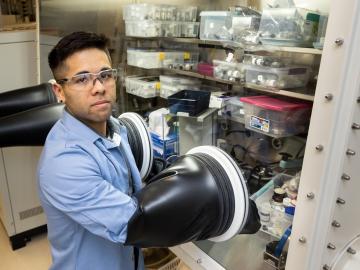
Filter News
Area of Research
- (-) Biology and Environment (44)
- (-) Materials (34)
- Advanced Manufacturing (1)
- Chemistry and Physics at Interfaces (1)
- Clean Energy (78)
- Data (1)
- Energy Frontier Research Centers (1)
- Functional Materials for Energy (1)
- Fusion and Fission (7)
- Isotope Development and Production (1)
- Isotopes (9)
- Materials Synthesis from Atoms to Systems (1)
- Materials Under Extremes (1)
- National Security (16)
- Neutron Science (8)
- Nuclear Science and Technology (5)
- Renewable Energy (1)
- Sensors and Controls (1)
- Supercomputing (9)
News Type
News Topics
- Big Data (1)
- Bioenergy (11)
- Biology (17)
- Biomedical (4)
- Biotechnology (2)
- Chemical Sciences (5)
- Clean Water (4)
- Climate Change (6)
- Composites (1)
- Computer Science (2)
- Coronavirus (2)
- Decarbonization (4)
- Energy Storage (2)
- Environment (24)
- Exascale Computing (1)
- Fusion (1)
- High-Performance Computing (5)
- Hydropower (2)
- Machine Learning (1)
- Materials (4)
- Materials Science (8)
- Mathematics (2)
- Mercury (3)
- Microscopy (7)
- Nanotechnology (4)
- Net Zero (1)
- Neutron Science (2)
- Nuclear Energy (2)
- Physics (7)
- Polymers (3)
- Quantum Computing (1)
- Simulation (3)
- Summit (1)
- Sustainable Energy (6)
Media Contacts

Andrea Delgado is looking for elementary particles that seem so abstract, there appears to be no obvious short-term benefit to her research.

For as long as he could remember, Brenden Ortiz wanted to do only one thing. “My childhood dream was to be a scientist. All I wanted to do was tinker in a lab like a pure scientist,” Ortiz said.

Chemist Jeff Foster is looking for ways to control sequencing in polymers that could result in designer molecules to benefit a variety of industries, including medicine and energy.

Benjamin Manard has been named to the editorial board of Applied Spectroscopy Practica, serving as an associate editor.

Alice Perrin is passionate about scientific research, but also beans — as in legumes.

Joanna Tannous has found the perfect organism to study to satisfy her deeply curious nature, her skills in biochemistry and genetics, and a drive to create solutions for a better world. The organism is a poorly understood life form that greatly influences its environment and is unique enough to deserve its own biological kingdom: fungi.

When Addis Fuhr was growing up in Bakersfield, California, he enjoyed visiting the mall to gaze at crystals and rocks in the gem store.

Hydrologist Jesús “Chucho” Gomez-Velez is in the right place at the right time with the right tools and colleagues to explain how the smallest processes within river corridors can have a tremendous impact on large-scale ecosystems.

Erica Prates has found a way to help speed the pursuit of healthier ecosystems by linking the function of the smallest molecules to their effects on large-scale processes, leveraging a combination of science, math and computing.

John “Jack” Cahill is out to illuminate previously unseen processes with new technology, advancing our understanding of how chemicals interact to influence complex systems whether it’s in the human body or in the world beneath our feet.


